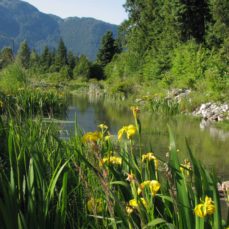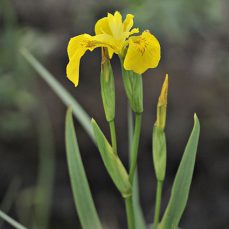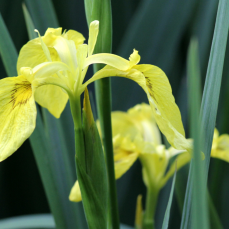

Management Strategy
Squamish
Whistler
Pemberton
Vectors of Spread
ID Characteristics
General: Yellow flag iris is an aquatic perennial with a fan-shaped base and yellow iris-shaped flowers. It is listed on the BC Weed Control Act as noxious in all regions of the province.
Flowers: Distinctive, iris-looking, bright yellow flowers, with three drooping, deep-yellow sepals and purple-brown markings surrounding three smaller upright petals. Flowers are 7 – 10 cm across.
Stem: Stems are in groups of 2-10, and grow 30cm to 1m tall. Stems don’t usually exceed the height of the leaves.
Leaves: Narrow, sword-shaped, flattened leaves (2 – 3 cm wide and up to 1 m long) with a prominent mid-rib. Leaves fan out from the base of the plant and may remain green during mild winters.
Seeds: Seeds are closely packed in rows within 4 – 8 cm long capsules that resemble small green bananas.
Roots: Stout orange rhizomes (1-4cm thick) that form dense mats. Rhizomes can withstand several months of drying.
Similar Species
Yellow flag iris is the only entirely yellow iris found in the wild of North America.
It is often confused with the native cattail (Typha latifolia), which has round stems and is taller than yellow flag iris.
You can refer to the Fraser Valley Invasive Species Society’s guide to help you tell yellow flag iris and cattail apart.

Yellow Flag Iris on the left, Native Cattail plant on the right
Other non-invasive irises include Oregon iris (Iris tenax).

Iris Tenax, Wikipedia (https://commons.wikimedia.org/wiki/File:Iris_Tenax,_Coastal_Oregon,_April_2015.jpg)
Habitat and Origin
There is some debate over the origins of yellow flag iris, but most sources claim it is native to Europe, Northern Africa, Asia, and the Mediterranean region. It was brought to North America as an ornamental plant, and is still widely sold in BC.
Yellow flag iris has traditionally been popular with landscapers and horticulturists, as it provides filtration, and thrives in wet areas such as ditches, irrigation canals, marshes, stream banks, lake shorelines, shallow ponds and well-watered garden beds. Yellow flag iris can tolerate a variety of salinities and pH levels. It prefers silty soils but will root in rocky substrates as well.
How it Spreads
Yellow flag iris spreads by floating seeds and by underground root systems, called rhizomes. A whole new plant stand can develop if a piece of rhizome breaks off and travels downstream.
The seedpods are buoyant and can remain afloat for up to 7 months, allowing them to spread over long distances down watercourses. Yellow flag iris also spreads by creeping rhizomes. Several hundred plants can be connected by rhizome underwater. In addition, small fragments of rhizome can break off, drift downstream and take root, forming new stands.
Yellow flag iris is still grown, sold and distributed in the horticulture trade (despite being recognized as provincially noxious in BC), which also contributes to its spread. Lastly, illegal green waste dumping or improper disposal of rhizomes may also contribute to the spread of yellow flag iris.
Impacts
Health
- Toxic if ingested by humans or livestock.
- Can cause skin irritation when touched.
Ecological:
- Outcompetes native vegetation such as cattails, sedges, and rushes.
- Limits the native species available for grazing, and reduces habitat for fish, amphibians, and nesting birds.
Economic:
- Dense mats trap sediment, thereby choking natural waterways, irrigation canals, and flood control ditches important in infrastructure and agricultural areas.
Stop the Spread
Yellow flag iris is found in the Sea to Sky region, but with a limited distribution. The goal is to eradicate this species from the region, and to prevent new introductions.
Learn to identify yellow flag iris: use the images presented on this page.
What to do if you spot it: You can report any yellow flag iris sighting by visiting our reporting page.
If you’re a boater or an eco-tourism professional, learn more in our free, 20-minute Aquatic Invasives 101 course!
DO
- Regularly monitor properties for infestations.
- Ensure soil and gravel are uncontaminated before transport.
- Remove plant material from any equipment, vehicles, or clothing used in infested areas and wash equipment and vehicles at designated cleaning sites before leaving these areas.
- Immediately re-vegetate disturbed wet areas with native plants such as Cattail (Typha latifolia) or other non-invasive marsh species to prevent opportunistic invasion of these areas by species such as Yellow Flag Iris.
- Ensure plants (particularly flowers, seeds and root fragments) are bagged and covered to prevent spread during transport to designated disposal sites (e.g., landfill).
DO NOT
- Plant yellow flag iris in gardens or ponds, no matter how well-enclosed an area might seem.
- DO NOT COMPOST
Control
Mechanical Control
At minimum, seed heads should be clipped, bagged, and disposed of to prevent further spread.
Repeatedly cutting the plant material close to the ground can help to deplete the plant’s root reserves, but the most effective method of eradication is digging up and pulling out the masses of rhizome. Using a mattock or crowbar, dig to the full depth of the plant (up to 30 cm deep), and remove all pieces of root from the area to prevent re-growth from fragments. Monitor regularly for re-growth and remove any new plants that appear.
Alternatively, the ‘benthic barrier’ method can be used on dense infestations with few other plants. This method entails cutting above-ground plants and covering the site with pond liner or heavy PVC matting for at least 70 days to deprive the plants of light and oxygen.
Note: To prevent skin irritation, wear gloves when handling Yellow Flag Iris.
Chemical Control
- Although some herbicides provide effective control of yellow flag iris, they cannot be applied in aquatic environments in Canada.
- Herbicide control is not recommended for this species.
Biological Control
- There is no current effective means of biological control in BC. yellow flag iris sickens animals if eaten, causing inflammation of the stomach and intestine.
Sea to Sky Distribution
Yellow Flag Iris Factsheet
Having trouble viewing the factsheet? Don’t worry, all the information is included on this page. You can also contact us with any questions.
Additional Resources
References
- Central Kootenay Invasive Species Society, Yellow Flag Iris
- Fraser Valley Invasive Species Society, Look-alike Guides
- Fraser Valley Invasive Species Society, Yellow Flag-Iris
- Invasive Species Council of BC, Yellow Flag Iris
- Invasive Species Council of BC, Yellow Flag Iris Factsheet
- Metro Vancouver, Best Management Practice for Yellow Flag Iris in the Metro Vancouver Region
- Metro Vancouver, Tackling Yellow Flag Iris
- Okanagan Invasive Species Online, Yellow flag iris
- Streichert, K. and Tasaroff, C., “Assessing benthic barriers as an effective yellow flag iris control mechanism”, TRU Research Report
- US Department of Agriculture Natural Resources Conservation Service, Yellow Flag Iris Species Profile























